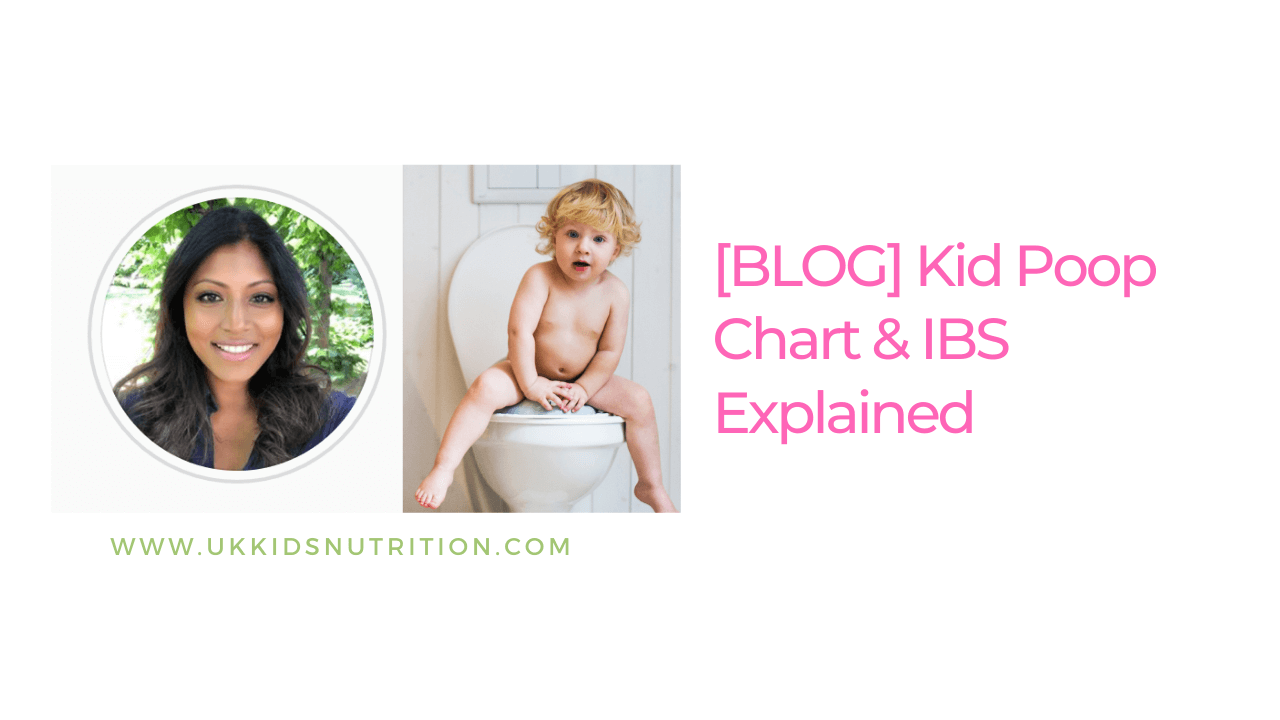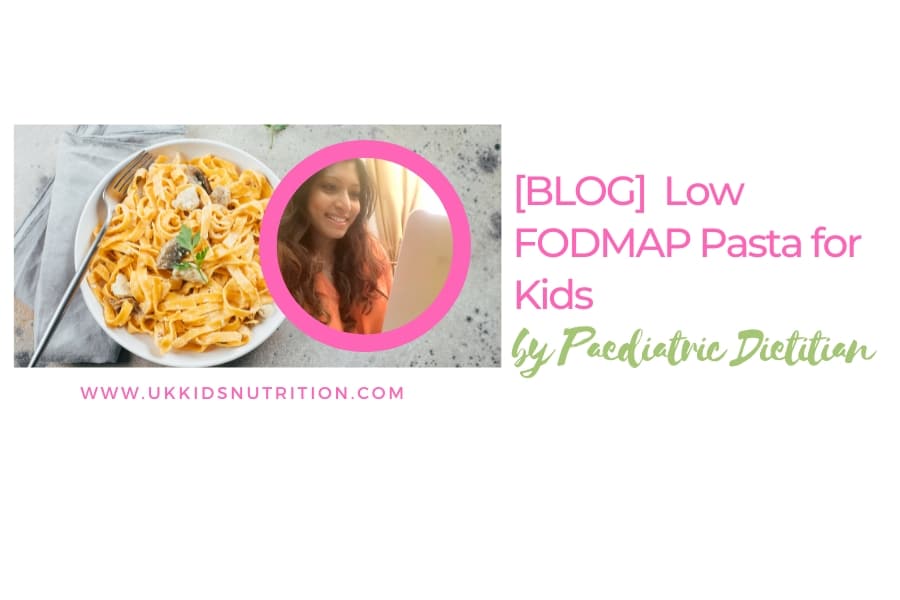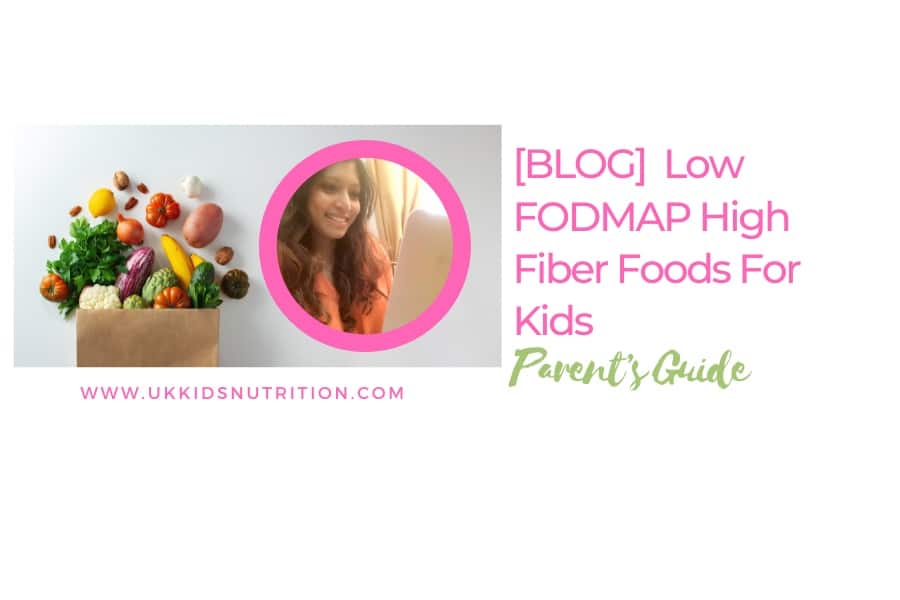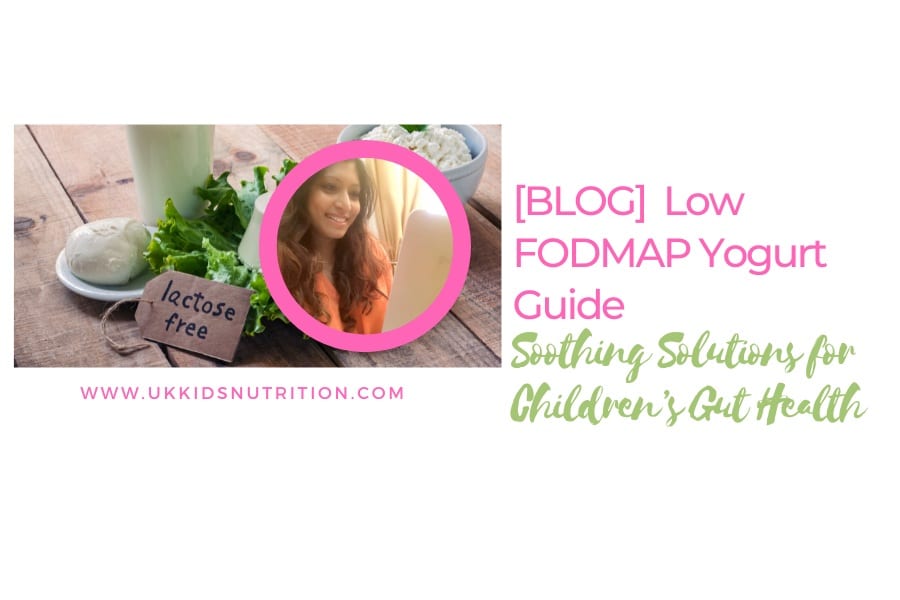Subscribe: Apple Podcast | Email | Spotify | Stitcher
I use the description ‘Kid Poop Chart’ a lot in my weekly Gut Health Clinic, so you might be wondering how to use it to analyse your child’s poo. Particularly if you also suspect IBS or irritable bowel syndrome in your child.
Your paediatric dietitian or paediatrician may also have shown you the Bristol stool chart.
So you probably want to know if it’s the same thing and how to use it to determine whether your child’s poop is normal or not.
If that’s the case, keep reading!
In this article, you’ll find a visual guide that will clearly explain the different types of poop.
This article will also explain how the kid poop chart compares to the adult Bristol stool chart and how to help your child pass normal poop. If you suspect that your child may have constipation, diarrhoea or irritable bowel syndrome, then I’ll also explain what these are and what you need to do.
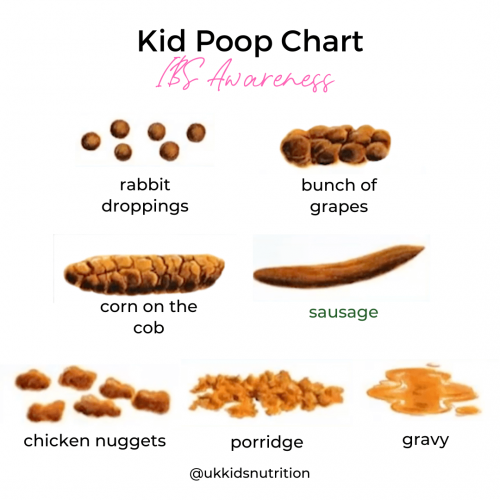
What is a kid poop chart?
A poop chart is essentially the Paediatric Bristol Stool Chart that has been simplified for children.
Your paediatric dietitian or doctor may show your child a kid-friendly version of the Bristol stool scale to help them talk about their poop.
It’s essentially a pictorial guide of the different types of poop to help your child find it easier to describe what their usual poop is like.
Visual aids in the absence of normal toddler poop pictures, can help your doctor make a diagnosis of constipation, diarrhoea or irritable bowel syndrome.
Note that it doesn’t explain how often your child should be pooping.
The poop chart also doesn’t highlight any other symptoms like abdominal pain that your child may also be experiencing.
It does, however, define the different types of poop in a clear and visually kid-friendly way.
What are the different types of poop?
Type 1 – Separate hard lumps
Looks like rabbit droppings
Type 2 – Lumpy and sausage-like
Looks like a bunch of grapes
Type 3 – Sausage shape with cracks on the surface
Looks like corn on the cob
Type 4 – Like a smooth soft sausage like a snake
Looks like a sausage
Type 5 – Soft blobs with clear-cut edges
Looks like several chicken nuggets
Type 6 – Mushy consistency with ragged edges
Looks like porridge
Type 7 – Liquid consistency with no solid pieces
Looks like gravy or thin sauce
What about toddler poop colour?
You’ll notice that most kid poop charts and Bristol stool charts generally don’t refer to the stool colour and the various colours of baby and toddler poop.
So let’s go through the stool colour chart and the different colours of kid poop. We’ll cover what’s normal and which toddler poop colour warrants medical attention.
We’ll keep referring to the Bristol Stool Chart for kids (the paediatric poop chart).
Yellow/brown stools
Yellow and brown are the colours of normal stools. If your baby’s poop has changed from yellow mustard or their poop is dark brown, this could be down to a change in what they’ve been eating.
Light brown poop is also perfectly normal and can also be referred to as the normal colour of stools.
Note that when toddlers have been eating darker coloured foods like chocolate or anything with food colouring, it’s natural that their poop changes to take on that colour.
Dark brown stools or anything ranging from mustard, yellow to brown are all normal colours of stools.
Green stools
It’s very common for babies to pass green-coloured poop. This is especially noticeable if there has been a change to their infant formula.
Babies who have recently changed from standard infant formula to an extensively hydrolysed or amino acid-based formula for the management of cow’s milk protein allergy may find that their poop changes from yellow to green.
This is perfectly normal and nothing to worry about.
If your baby or toddler passes green stools with fever and becomes unwell, then do speak to your family doctor for advice.
Black toddler poop
One-off black stools could be down to food colouring but if this persists it could be a sign of blood in their stools. Speak to your child’s doctor or paediatrician for medical advice.
Red toddler poop
Chances are that your toddler has been eating brightly coloured beetroot or other food containing red food colouring.
But if that isn’t the case, then it could be fresh red blood due to a tear when passing a poop. If it’s only a small red streak within their poop, this could be down to a tear when your child pushed out a large stool.
If this happens regularly do speak with your family doctor or paediatric dietitian for help managing symptoms of constipation.
Picky eaters are particularly prone to constipation.
Working with a paediatric dietitian can help resolve the problem.
My 1-2-1 coaching programme ‘Fussy Eating solutions’ might be just what you need if your toddler or school-aged child is a picky eater with persisting constipation.
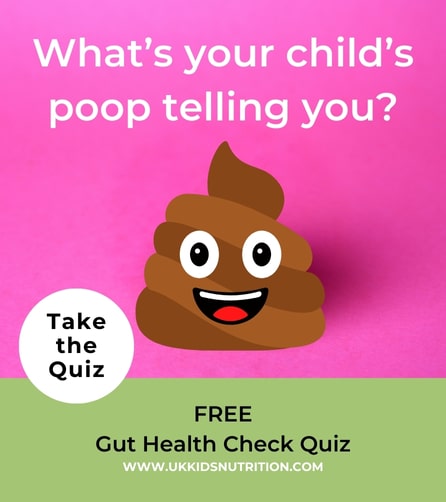
White stools
White or very pale stools are not normal and should be discussed with your child’s doctor straight away.
Problems with the liver or bile ducts can cause very pale stools.
This is a serious medical problem and may also be accompanied by other symptoms like vomiting and severe abdominal pain.
One pale stool isn’t anything to be worried about but if it’s frequent and is accompanied by any other symptoms seek medical attention immediately.

What is constipation?
When the majority of your child’s poop is hard, large or painful to pass, then when compared to this kid poop chart, your child’s poop will look more like type 1 (resembling rabbit droppings) or type 2 (like a bunch of grapes).
Definition of constipation in babies and toddlers up to 4 years of age
According to the Rome VI criteria, constipation in young children can be defined as below.
Your child must have experienced these symptoms for one month for at least two of the following symptoms.
- Passes two or fewer stools per week
- History of withholding poo
- History of painful or hard bowel movements (in kid poop chart will appear like type 1 or type 2)
- History of large bowel movements in children
- Presence of large faecal mass (poop) in the rectum (when examined by a physician)
In toilet-trained children (additional criteria)
- At least one episode per week of incontinence (despite being toilet-trained)
- History of very large poop that can block the toilet
For tips on how to manage constipation in babies and toddlers, see ‘How To Help Constipation In Babies & Toddlers’
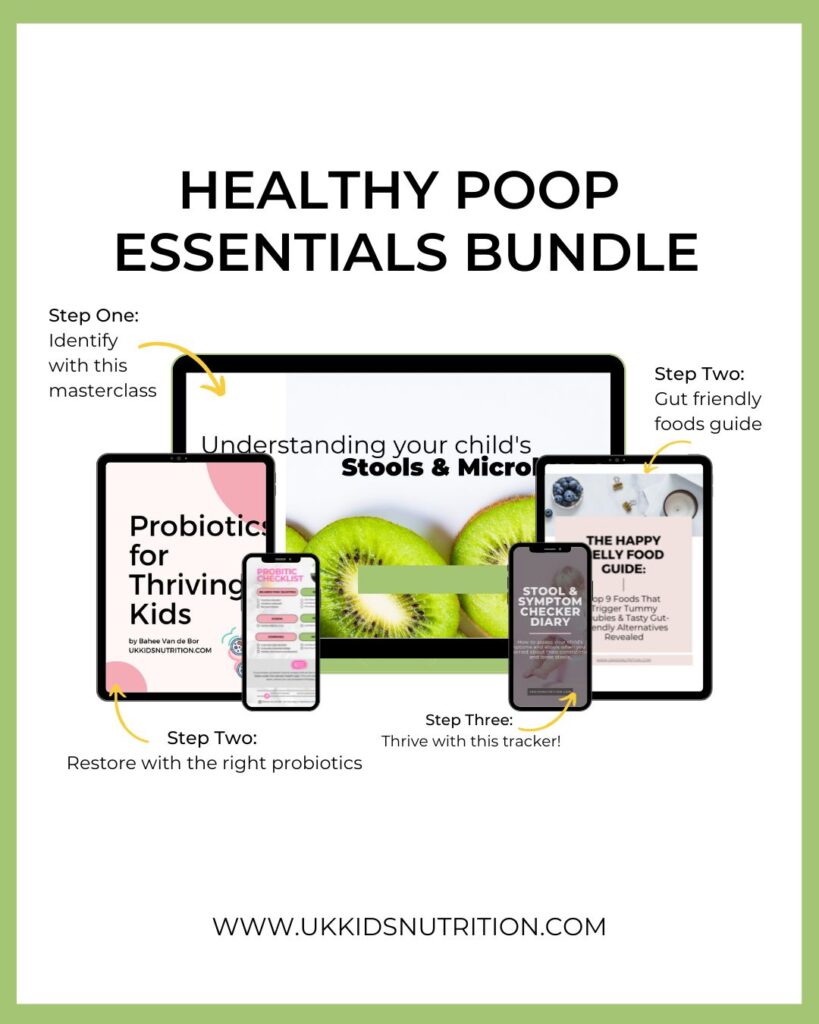
What is diarrhoea?
If your child mostly describes their poop as type 6 (resembling porridge) to 7 (looking like gravy) from the kid poop chart, then their stools are more on the ‘loose’ to watery.
Rome criteria for diagnosing functional diarrhoea
Must have all of the following symptoms described below:
- Daily, painless watery poop (4 or more episodes per day)
- Symptoms have lasted for over 4 weeks
- Symptoms began from 6 months to 60 months of age
What is paediatric IBS?
Irritable bowel syndrome (IBS) is a digestive problem in children and adolescents where constipation or diarrhoea is one of their main problems.
IBS is therefore a collection of symptoms as outlined below:
- Abdominal pain (usually central or lower tummy pain that improves after pooping)
- Bloating with or without a visibly distended tummy
- Excessive wind
- Diarrhoea with urgency (with or without nappy rash)
- Constipation with soiling and/or with the feeling of incomplete emptying of the bowel

What does IBS poop look like?
IBS poop can vary from constipation or hard poop type 1-2 on the kid poop chart. In these children, constipation will be their most prominent symptom.
Children with IBS-type diarrhoea experience loose/watery poo described as type 5-7.
In IBS it is, therefore, possible for children to predominantly experience only one problem like constipation or diarrhoea.
Other children may notice that their poop fluctuates between normal (sausage-shaped that is soft and easy to pass) or hard or loose and watery.
Can kids have mixed-type poop?
Yes, absolutely. In both adults and children with IBS, symptoms can fluctuate between constipation and diarrhoea.
What causes IBS in children?
The exact cause of IBS is not known.
Family history is one known risk factor. This means that if you or another family member has IBS then your child has a higher chance of also being diagnosed with IBS.
Factors thought to contribute to IBS in adults include:
- Altered bowel motility
- Visceral hypersensitivity
- Impaired perception and processing of pain by the brain
- Low-grade inflammation
- Alterations of gut microbial flora

What are the other symptoms of IBS?
IBS is often diagnosed after ruling out other more serious gastrointestinal conditions like coeliac disease and Crohn’s disease.
Your family doctor may ask you about your family history. Children with a history of food allergy and other members of the family diagnosed with IBS are more likely to also suffer from IBS.
Other symptoms associated with irritable bowel syndrome include:
- Lower tummy pain
- Diarrhoea with urgency (+ nappy rash in younger children)
- Constipation with a feeling of incomplete evacuation
- Problems with soiling
- Bloating (the feeling that there is an inflated balloon inside the belly)
- Excess wind or gas
- Distention (the tummy is visibly distended)
These symptoms may suggest an underlying food intolerance but please do not be tempted to buy a food intolerance test.
How does IBS present in toddlers and young children?
- Your child may seem to be withdrawn or irritable.
- They may have ongoing unformed poop (mostly loose)
- You struggle with potty training
- You notice irritability and a recent change in their mood or behaviour
How is IBS diagnosed in children?
ROME IV diagnostic criteria are used to diagnose children with IBS after ruling out other more serious medical conditions related to the gut.
Criteria for diagnosing children with IBS
- Abdominal pain for at least 4 days per month associated with the following:
- Related to pooping
- A change in the frequency of pooping
- A change in the appearance of stools
- In children with constipation, the pain does not resolve with the resolution of constipation (for example with the use of laxatives)
- After appropriate investigations and assessments symptoms cannot be fully explained by another medical condition
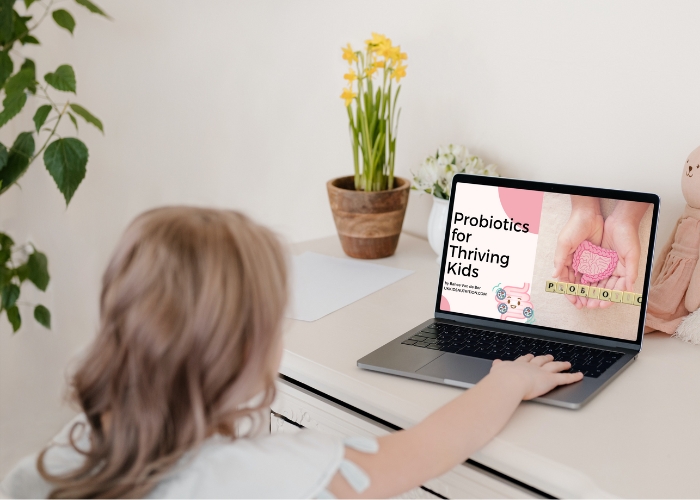
Bottomline
The kid poop chart can be a brilliant conversation starter for getting kids to talk about their poop.
It can also help explain what the different types of poop are and what type of poop is more likely to fall under constipation and diarrhoea.
If you suspect that your child’s persistent constipation or diarrhoea is linked to IBS, then do speak with a paediatric gastroenterologist or enquire about my IBS Kids Programme.
Let Me Help
Would you like to meet a children’s dietitian who has successfully helped families solve their nutrition problems from around the world?
No matter what you are worried about, I’ll help you manage these with confidence.
